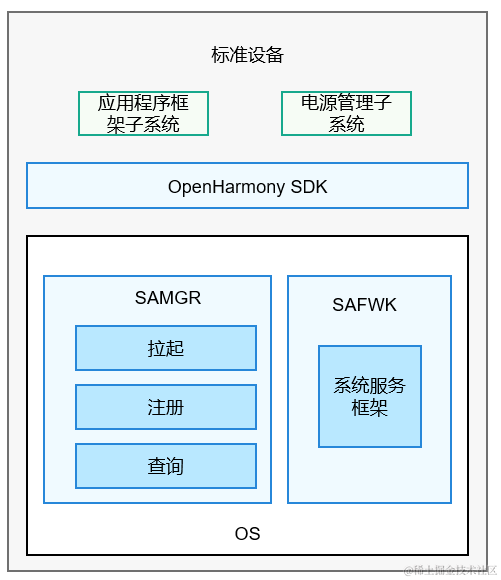鸿蒙开发实战:【系统服务框架部件】
简介
在系统服务管理子系统中safwk组件定义OpenHarmony中SystemAbility的实现方法,并提供启动、注册等接口实现。
系统架构
图 1 系统服务框架图

说明
接口说明
使用说明
SystemAbility实现一般采用XXX.cfg + profile.json + libXXX.z.so的方式由init进程执行对应的XXX.cfg文件拉起相关SystemAbility进程。
C++实现SystemAbility
示例代码如下:
- 1. 定义IPC对外接口IXXX
定义该服务对外提供的能力集合函数,统一继承IPC接口类IRemoteBroker;同时实现该IPC对外接口唯一标识符DECLARE_INTERFACE_DESCRIPTOR(XXX);该标识符用于IPC通信的校验等目的。
namespace OHOS {
class IListenAbility : public IRemoteBroker {
public:
virtual int AddVolume(int volume) = 0;
public:
enum {
ADD_VOLUME = 1,
};
public:
DECLARE_INTERFACE_DESCRIPTOR(u"OHOS.test.IListenAbility");
};
}
- 2. 定义客户端通信代码XXXProxy
namespace OHOS {
class ListenAbilityProxy : public IRemoteProxy<IListenAbility> {
public:
int AddVolume(int volume);
explicit ListenAbilityProxy(const sptr<IRemoteObject>& impl)
: IRemoteProxy<IListenAbility>(impl)
{
}
private:
static inline BrokerDelegator<ListenAbilityProxy> delegator_;
};
} // namespace OHOS
- 3. 定义服务端通信代码XXXStub
namespace OHOS {
int32_t ListenAbilityStub::OnRemoteRequest(uint32_t code,
MessageParcel& data, MessageParcel &reply, MessageOption &option)
{
switch (code) {
case ADD_VOLUME: {
return reply.WriteInt32(AddVolume(data.ReadInt32()));
}
default:
return IPCObjectStub::OnRemoteRequest(code, data, reply, option);
}
}
}
- 4. SystemAbility的实现类
namespace {
constexpr OHOS::HiviewDFX::HiLogLabel LABEL = {LOG_CORE, 0xD001800, "SA_TST"};
}
REGISTER_SYSTEM_ABILITY_BY_ID(ListenAbility, DISTRIBUTED_SCHED_TEST_LISTEN_ID, true);
ListenAbility::ListenAbility(int32_t saId, bool runOnCreate) : SystemAbility(saId, runOnCreate)
{
HiLog::Info(LABEL, ":%s called", __func__);
HiLog::Info(LABEL, "ListenAbility()");
}
ListenAbility::~ListenAbility()
{
HiLog::Info(LABEL, "~ListenAbility()");
}
int ListenAbility::AddVolume(int volume)
{
pid_t current = getpid();
HiLog::Info(LABEL, "ListenAbility::AddVolume volume = %d, pid = %d.", volume, current);
return (volume + 1);
}
void ListenAbility::OnDump()
{
}
void ListenAbility::OnStart()
{
HiLog::Info(LABEL, "ListenAbility::OnStart()");
HiLog::Info(LABEL, "ListenAbility:%s called:-----Publish------", __func__);
bool res = Publish(this);
if (res) {
HiLog::Error(LABEL, "ListenAbility: res == false");
}
HiLog::Info(LABEL, "ListenAbility:%s called:AddAbilityListener_OS_TST----beg-----", __func__);
AddSystemAbilityListener(DISTRIBUTED_SCHED_TEST_OS_ID);
HiLog::Info(LABEL, "ListenAbility:%s called:AddAbilityListener_OS_TST----end-----", __func__);
HiLog::Info(LABEL, "ListenAbility:%s called:StopAbility_OS_TST----beg-----", __func__);
StopAbility(DISTRIBUTED_SCHED_TEST_OS_ID);
HiLog::Info(LABEL, "ListenAbility:%s called:StopAbility_OS_TST----end-----", __func__);
return;
}
void ListenAbility::OnStop()
{
}
- 5. SystemAbility配置
以c++实现的SA必须配置相关System Ability的profile配置文件才会完成SA的加载注册逻辑,否则没有编写profile配置的System Ability不会完成注册。配置方法如下:
在子系统的根目录新建一个以sa_profile为名的文件夹,然后在此文件夹中新建两个文件:一个以serviceId为前缀的json文件,另外一个为BUILD.gn文件。
serviceid.json:
{
"process": "listen_test",
"systemability": [
{
"name": serviceid,
"libpath": "liblisten_test.z.so",
"run-on-create": true,
"distributed": true,
"dump_level": 1
}
]
}
BUILD.gn:
import("//build/ohos/sa_profile/sa_profile.gni")
ohos_sa_profile("xxx_sa_profile") {
sources = [
"serviceid.json"
]
subsystem_name = "systemabilitymgr"
}
说明:
- 进程名字即该SystemAbility要运行的进程空间,此字段是必填选项。
- 一个SystemAbility配置文件只能配置一个SystemAbility节点,配置多个会导致编译失败。
- SystemAbility的name为对应的serviceId必须与代码中注册的serviceId保持一致,必配项。
- libpath为SystemAbility的加载路径,必配项。
- run-on-create:true表示进程启动后即向samgr组件注册该SystemAbility;false表示按需启动,即在其他模块访问到该SystemAbility时启动,必配项。
- distributed:true表示该SystemAbility为分布式SystemAbility,支持跨设备访问;false表示只有本地跨IPC访问。
- bootphase:可不设置;可以设置的值有三种:BootStartPhase、CoreStartPhase、OtherStartPhase(默认类型),三种优先级依次降低,当同一个进程中,会优先拉起注册配置BootStartPhase的SystemAbility,然后是配置了CoreStartPhase的SystemAbility,最后是OtherStartPhase;当高优先级的SystemAbility全部启动注册完毕才会启动下一级的SystemAbility的注册启动。
- dump-level:表示systemdumper支持的level等级,默认配置1。
- BUILD.gn中subsystem_name为相应部件名称;sources表示当前子系统需要配置的SystemAbility列表,可支持配置多个SystemAbility。
以上步骤完成后,全量编译代码后会在out路径向生成一个以进程名为前缀的json文件listen_test.json;路径为:out...\system\profile\listen_test.json。
更多鸿蒙开发知识已更新qr23.cn/AKFP8k可前往参考学习。

- 6. cfg配置文件
cfg配置文件为linux提供的native进程拉起策略,开机启动阶段由init进程解析配置的cfg文件进行拉起。
{
"jobs" : [{
"name" : "post-fs-data",
"cmds" : [
"start listen_test"
]
}
],
"services" : [{
"name" : "listen_test",
"path" : ["/system/bin/sa_main", "/system/profile/listen_test.json"],
"uid" : "system",
"gid" : ["system", "shell"]
}
]
}